All stats through 7/31/2021.
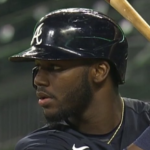 1. Michael Harris, OF
1. Michael Harris, OF
Age: 20 | Bats: L
.297/.343/.438 | 110 wRC+ | 5 HR | 18 SB | 6.1% BB | 18.2% K (A+)
Acquired: Drafted, 3rd Round – 2019
Prior Ranking: 10
No Braves prospect had more hype placed on him going into this season than Harris, and for the most part he has lived up to it. Harris has shown good all-fields power with a quick bat and a feel to hit. He loves to line balls down the lines and let his plus speed play on the base-paths, but he should develop more consistent over-the-fence pop in time. Right now he is slightly too aggressive and gives away too many at-bats with impatient swings, but this is a more recent observation.
His speed easily translates to the outfield, and he typically takes good routes and routinely makes difficult plays. This is true for all three outfield spots, but he seems most home in centerfield.
Harris is currently coming out of a month-long slump, showing that he still has some development. Specifically he looked to be pressing at the plate as teammate Jesse Franklin has heated up and the Rome team has started sinking in the standings. That said, he looks to be trying to bring in more plate discipline. He’s not a finished product, but Harris is the top all-round prospect in the Braves minors at this time and a potential superstar in the making.
 2. Cristian Pache, OF
2. Cristian Pache, OF
Age: 22 | Bats: R
.198/.267/.338 | 80 wRC+ | 7 HR | 4 SB | 7.7 BB% | 32.2 K% (AAA/MLB)
Acquired: International Amateur Free Agent – 2015
Prior Ranking: 1
Pache was essentially handed the Braves centerfield job out of spring training after a strong 2019 minor league season and showing out well when pressed into service against the Dodgers in the NLCS last post-season. Pache failed to hold onto the job however, going only 4-for-30 before straining his left groin and missing half of April. He returned in early May and again looked lost at the plate, going 3-for-33 before getting hurt again, this time straining his right hamstring. When Pache was pronounced well, he was optioned back to AAA Gwinnett to try to get his swing back. He has been hampered periodically all season with the hamstring problem, but he looks to have turned a corner in July, playing in 21 games.
He also looks far better at the plate now than he did in his looks with Atlanta as well, where his swing had gotten too long as he was trying to reach outside pitches and shoot them opposite field, but couldn’t hold up against quality breaking pitches while also leaving him vulnerable inside. He’s gone back to the swing that had him as one of the top hitters in the minors in 2019, keeping his hands in with a stronger leg kick and working pitchers middle-to-pull. His overall slash line is still low, but he’s putting altogether more competitive at-bats. He still has pitch recognition issues that may ultimately limit his offensive upside, but he should hit for power from the second half of a line-up.
Pache has plus speed as well that he employs better in the outfield than on the bases. It’s unclear what his continued hamstring issues will do long-term, but assuming he completely heals he should resume being a top-notch defender capable of multiple Gold Glove awards.
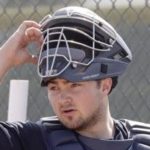 3. Shea Langeliers, C
3. Shea Langeliers, C
Age: 23 | Bats: R
.251/.329/.516 | 128 wRC+ | 17 HR | 1 SB | 9.2% BB | 26.5% K (AA)
Acquired: Drafted, 1st Round – 2019
Prior Ranking: 5
Langeliers was already established as the top defensive catcher in the Braves system and had a clear major league path as such. This season however changes to his swing started last spring and worked on at the Alternate Training Site during the lost season have fully taken root. As a result, Langeliers has been able to tap into his raw power more in games and has hit 25 extra base hits in 66 games as of this writing, including 17 home runs. That is an impressive total anywhere, but especially at Mississippi’s Trustmark Park, a home field that suppresses home runs.
Langeliers’ previous swing was flat and grooved, and resulted in a 40.4% groundball rate. His reworked swing has his hands starting closer to the body and lower, allowing him to work the head of the bat with his wrists easier. He now pulls the ball with more authority, but doesn’t sacrifice opposite field hitting. His groundball rate has dropped to 27.3% while his strikeout rate has only nudged up to 26.5%.
Langeliers also as a plus-plus arm and has adapted quickly to the one-knee-down catching style now favored by Atlanta. He’s already called one no-hitter this season and pitchers seem to love throwing to him. He moves up the ranking as his outlook is now firmly in the “future major league starting catcher” area.
 4. Drew Waters, OF
4. Drew Waters, OF
Age: 22 | Bats: S
.256/.342/.431 | 106 wRC+ | 8 HR | 17 SB | 9.4% BB | 32.0% K (AAA)
Acquired: Drafted, 2nd Round – 2017
Prior Ranking: 2
It’s been an extremely up-and-down season for Waters, mostly for reasons of health as he’s been sidelined several times during the course of the season, but nothing serious. July has been his healthiest month, and he’s hit .301/.351/.573 during the month with 5 homers and 5 stolen bases with a 29% strikeout rate.
That last bit is important, as his season K-rate is too high. While the negative effects of high strikeout rates are often overstated by fans and broadcasters, strikeout rates above ~25% do start limiting impact outside of extreme cases of high-power, high-walk, good defense players like Joey Gallo. It’s too fine a needle to thread for Waters, so recent improvement is good. Waters however remains an extremely aggressive hitter, and pitchers with good control can exploit this as his pitch recognition lags behind his other offensive skills. One very positive development has been his strength this year as a right-handed hitter; this was his weaker side coming up through the minors, but he reportedly put a lot of effort into this swing during the shutdown, and it seems to be bearing fruit (.321/.411/.551 vs left-handed pitchers).
Waters is a plus defender at the corner outfield spots and above average in centerfield. He has a plus arm, and the occasional lapses of inattention that plagued him in prior years seems to be under control. As with everything else, Waters is an extremely aggressive baserunner, to the point of driving the other team to distraction.
Waters is still only 22 years old and performing well in his first full season of AAA baseball. There is a shot he could get the call up to Atlanta later this year, especially if the Braves fall out of contention, and he’ll need to be added to the 40-man roster this offseason to keep him out of the Rule 5 draft.
 5. Kyle Muller, LHP
5. Kyle Muller, LHP
Age: 23
3.30 ERA | 3.47 FIP | 16 G, 15 GS | 71.0 IP | 4.56 BB/9 | 11.28 K/9 (MLB/AAA)
Acquired: Drafted, 2nd Round – 2016
Prior Ranking: 6
Muller had a breakout 2019 season for AA Mississippi and would likely have made it up to AAA if not for a leg injury that cost him his last month of the season. This season he made his AAA debut and was roughed up his first four starts before flipping a switch and pitching to a 1.69 ERA in three outings before getting called up to fill in the Atlanta rotation, replacing the injured Tucker Davidson, who was replacing the injured Huascar Ynoa, who was replacing the injured Mike Soroka. The start of his major league career couldn’t have gone much better as he has a 2.43 ERA in 7 outings (6 starts).
The primary adjustment Muller has seemed to make has been to slightly shorten his arm path. He used to pull deep from around his back to get the leverage for high-90s four-seam fastballs. Shortening the arm path has caused him to lose a few mph, but has allowed for more deception and consistency in his release point. His slider, a great 10-to-4 breaker when its on, is much more competitive now that it comes out of the same spot as the fastball. His traditional curveball is currently his best strikeout pitch however, and so far he’s done a nice job dotting the bottom of the strikezone with the pitch.
Other than maybe dipping back down to Gwinnett to get work in when a 5th starter isn’t needed, I’m guessing Muller will be with the big league club to stay, even after the return of injured pitchers Toussaint, Ynoa, and perhaps Davidson. While he’s solidified his starting pitcher bone-fides it doesn’t take much imagination to see him become a high-leverage fireman from the bullpen.
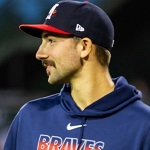 6. Spencer Strider, RHP
6. Spencer Strider, RHP
Age: 22
4.03 ERA | 2.86 FIP | 14 G, 14 GS | 58.0 IP | 4.34 BB/9 | 15.21 K/9 (AA/A+/A)
Acquired: Drafted, 4th Round – 2020
Prior Ranking: 20
The organization was careful with Strider coming out of minor league spring training, holding his pro debut back until the second week of the season and carefully ramping up his pitch count. The wait as worth it however, as he quickly established that low-A was child’s play for him as he allowed only 1 run in 15.1 innings over 4 starts while striking out an eye-popping 32. June saw Strider jump to high-A Rome, where the results were similar, 4 runs in 14.2 innings over 3 starts, striking out 24. Strider seems to have found his level for now in AA Mississippi, where he’s been dealing with some adversity as he has a 6.65 ERA at the level over 6 games.
Strider pretty much threw exclusively fastballs while in low-A, and why not when no one could really touch the high-90s heat spotted where he wanted it. In high-A he started incorporating the spiked curveball (modelled on Luke Jackson‘s breaking ball), and at AA he’s been slowly mixing in the change-up. Currently he’s working through some issues with his release point and feel for all three pitches, and AA hitters are much better at punishing mistakes. These are lessons to learn, but his pure stuff has moved to the front of the class of ’20.
With his pitch count likely to remain in the 80-90 range for now, it seems likely Strider will ride out the rest of the season in AA, then get his chance to impress coaches next spring. With just a few refinements and a little more consistency, he has the stuff to possibly be a major league contributor in 2022.
 7. Tucker Davidson, LHP
7. Tucker Davidson, LHP
Age: 25
2.25 ERA | 3.56 FIP | 7 G, 7 GS | 40.0 IP | 2.70 BB/9 | 9.00 K/9 (MLB/AAA)
Acquired: Drafted, 19th Round — 2016
Prior Ranking: 7
Davidson started his first AAA season debut in strong fashion, going 7 innings in both of his first two starts and surrendering a total of one earned run. This got him a spot start with Atlanta and he put up a solid 6 innings with 3 runs allowed. After another strong AAA start, Davidson was recalled to replace the injured Huascar Ynoa. After two good starts however, his third start went awry as Davidson started feeling tightness in his left forearm. Forearm tightness is often a pre-cursor for UCL problems, but an MRI indicated only inflammation. The Braves are playing it cautiously with Davidson, and they put him on the 60-day injured list.
Davidson came out of the shutdown with improved velocity and movement on his fastball and sharper secondaries, which includes a change, curve, and slider. The curve has traditionally been his best breaker coming up through the system, but the slider has pretty much matched it now, giving hitters facing Davidson a tough battle as to how any particular pitch will break. Davidson will occasionally have boughts of wildness, but those are getting more and more rare. Command can still be elusive as well, but he has steadily improved to the point that he should still be able to remain in a starting rotation, health permitting.
And the health question is the reason he remains static on the list for this update. Forearm inflammation is something that can happen to any pitcher, but without a clear idea of the cause it remains a flashing yellow light.
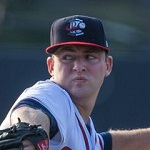 8. Jared Shuster, LHP
8. Jared Shuster, LHP
Age: 22
3.28 ERA | 3.85 FIP | 10 G, 9 GS | 35.2 IP | 2.52 BB/9 | 11.36 K/9 (A+)
Acquired: Drafted, 1st Round – 2020
Prior Ranking: 8
While draft-mates Strider and Bryce Elder have zoomed up to AA, Shuster has remained in high-A and it doesn’t look like that will change soon. It’s not because he’s pitched poorly — he hasn’t — but it’s clear that his arm strength isn’t where the others are at this point after being held back most of May while working on his mechanics and his pitch counts have remained in the 45-65 range all season. It is somewhat similar to Atlanta’s handling of Ian Anderson in his first full pro season.
The mid-90s velocities Schuster was sporting his junior year of college have settled now in the low-90s. That’s plenty enough velocity however to make his plus change-up play well. He spots both pitches well, especially early in a game, and that’s typically more than enough to keep high-A hitters off-stride. He hides the ball well so that both pitches play up and work off each other. His third pitch is very much a work-in-progress however as he tries to tighten up the loopy curveball he showed in college. His control and command are strong, especially with the change-up, at least until the end of his outings when fatigue starts to have him lose a little sharpness.
There’s no big hurry to get Shuster to the majors, and I expect the organization to continue to play it conservatively through the rest of 2021. That said, it wouldn’t take much further development for his stuff to play at higher levels.
 9. Bryce Elder, RHP
9. Bryce Elder, RHP
Age: 22
2.96 ERA | 3.77 FIP | 15 G, 15 GS | 82.0 IP | 3.84 BB/9 | 9.88 K/9 (A+)
Acquired: Drafted, 5th Round – 2020
Prior Ranking: 19
Elder has quickly established himself as a workhorse starting pitcher, regularly being allowed pitch counts pushing or exceeding 90. After throwing 45 innings with high-A Rome with a 2.60 ERA, Elder matriculated to Mississippi in late June. He’s actually been hit less in AA, holding hitters to a .176/.268/.304 mark, and he has gone 7 innings in his last four outings, including a combined no-hitter.
Elder has repeatable, uncomplicated mechanics that allow him to pitch effectively without maximum effort. While he had plenty of stuff to overwhelm high-A hitters, he’s more of a pitch-to-contact groundball pitcher, looking to induce early contact with his low-90s sinker and hard-breaking slider. One of the bigger positive surprises has been the progression of his curveball, which was an afterthought in college. It has good shape and drop, and he can usually get it over for strikes to get himself back into counts.
Of the three pitchers of the 2020 draft, Elder has the highest floor and has all of the makings to a solid back-end starter.
 10. Ryan Cusick, RHP
10. Ryan Cusick, RHP
Age: 21
4.24 ERA | 3.30 FIP | 12 G, 12 GS | 70.0 IP | 4.11 BB/9 | 13.89 K/9 (NCAA – ACC)
Acquired: Drafted, 1st Round — 2021
Prior Ranking: N/A
Atlanta’s 1st-round pick (24th overall) in the 2021 draft, Cusick is a big bodied (6′-6″, 235 lbs) right-hander who comes out of the draft with one of if not the highest-rated fastballs, reaching into 100+ mph territory with good life. Cusick also has a good breaking ball that has inconsistent shape and a rudimentary change-up.
The question now is how the Braves will develop him. If they keep him as a starter, I expect him to mostly work out of North Port, developing those secondaries. If they want to switch him over to a reliever, he could start moving aggressively through the organization. There’s been signals both ways, but either way Cusick exudes confidence in his abilities.
 11. Braden Shewmake, SS
11. Braden Shewmake, SS
Age: 23 | Bats: L
.234/.278/.416 | 88 wRC+ | 8 HR | 2 SB | 5.3% BB | 20.2% K (AA)
Acquired: Drafted, 1st Round – 2019
Prior Ranking: 9
Swing changes are always tough, and Shewmake’s attempts to generate more loft in his swing this season lead to a ghastly first six weeks of the season (.127/.176/.229). Since then Shewmake seems to have found a happy middle ground with the swing at this point and his production has seen the benefit, hitting .370/.408/.663 since mid-June with 5 of his 6 home runs during that period.
When Shewmake joined the Braves, he was using his hands and wrists to flick the bat at the ball for a high-contact swing that likely would have been non-competitive at higher levels with better defenses. Over the shutdown, Shewmake and the Braves re-tooled his swing, closing off and trying to stay back on the ball to allow him to hit with more authority up the middle and allow him, to put it in his own words, get more one-hop line drives off the wall. Shewmake struggled initially when his re-tooled swing met actual competition, but all things considering he seems to have adjusted well.
Defensively, Shewmake has good hands and instincts at shortstop. His arm is strong though it can get long at times. He has above average speed on the base-paths as well. Shewmake is a well-rounded baseball player without a standout tool but enough feel to hit and field that should eventually make him a valued major leaguer.
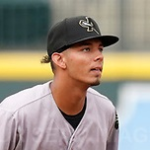 12. Vaughn Grissom, 3B
12. Vaughn Grissom, 3B
Age: 20 | Bats: R
.308/.410/.456 | 140 wRC+ | 5 HR | 8 SB | 11.9% BB | 15.1% K (A)
Acquired: Drafted, 11th Round – 2019
Prior Ranking: 17
Grissom and Michael Harris were the two teenagers invited to the Alternate Training Site, indicating their standing within the organization. Braves VP of Player Development Ben Sestanovich said of Grissom, “He continued to impress with very mature at-bats. He has a very good sense of the strike zone for a young kid. Early on, looks like he has the knack to make contact and find the barrel.” This has turned out to be true in his first taste of full-season ball with Augusta.
Grissom has demonstrated good bat-to-ball skills and he is willing to go all fields. As the season has progressed, he’s also shown a willingness to pull for power, especially in the weeks since a one-month IL stint. He can get fooled by quality off-speed, and his bat speed is just a little off to compete against high velocity; these will improve with experience.
Defensively he’s primarily playing third base, though he occasionally shifts over to short. He seems likely to grow off shortstop completely before too long. His arm is strong and accurate, and he has good instincts already for third.
 13. Freddy Tarnok, RHP
13. Freddy Tarnok, RHP
Age: 22
4.19 ERA | 3.82 FIP | 9 G, 7 GS | 38.2 IP | 3.72 BB/9 | 16.06 K/9 (AA/A+)
Acquired: Drafted, 3rd Round – 2017
Prior Ranking: 21
Tarnok has gotten past a rotator cuff issue in 2019 and a lat strain suffered during spring training to finally reach AA a couple of weeks ago.
That said, Tarnok was always going to be a slow burn through the system, given he only started pitching his sophomore year of high school. What pushed Tarnok up this list besides his improved major league proximity is generally better life on all of his pitches. His fastball sits mid-90s up in the zone, then he works the curve and change-up low. He’s shown better feel for both secondaries, though command of all of his pitches can slip. Tarnok works best when he releases from a high three-quarters, which allows his fastball to rise and his change-up to tumble.
His first brush with AA has been successful, and in his last outing he struck out a career high 12 batters.
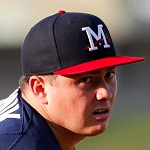 14. Victor Vodnik, RHP
14. Victor Vodnik, RHP
Age: 21
5.01 ERA | 4.64 FIP | 8 G, 8 GS | 23.1 IP | 5.79 BB/9 | 10.80 K/9 (AA)
Acquired: Drafted, 14th Round – 2018
Prior Ranking: 13
Vodnik was challenged with a AA assignment coming out of an impressive spring training, and he looked up to the challenge for his first three starts. Then he sustained an undisclosed injury in his fourth start which kept him out for five weeks. Since his return, he’s struggled with his control, though his last start on Tuesday looked to be a return to form.
When healthy, Vodnik has three potential plus pitches — four-seam fastball, slider, and change-up. As a reliever the fastball can land in the 99 mph range, but it sits 93-96 as a starter. The slider can be a strikeout pitch, and the change-up is developing quickly. The question on Vodnik at this point is simply his future role; there aren’t that many 6′-0″ starters, and his max-effort delivery seems more designed for shorter stints. Even if his future is in the bullpen however, I am more than comfortable with this ranking.
 15. Jesse Franklin, OF
15. Jesse Franklin, OF
Age: 22 | Bats: L
.252/.324/.560 | 128 wRC+ | 19 HR | 15 SB | 9.3% BB | 27.0% K (A+)
Acquired: Drafted, 3rd Round – 2020
Prior Ranking: 28
Other than scrimmages at the Alternate Training Site last summer, Franklin had not played in games since 2019 before spring training, losing his shortened junior season to a broken collarbone followed by the pandemic shutdown. It was perhaps a given that Franklin would have slow start, especially after he was challenged with a high-A assignment for his pro debut.
And start slow he did, hitting .200/.228/.253 in May. When the calendar flipped however, Franklin exploded, and he has hit all of his league-leading 19 home runs in that time. Coming out of college, Franklin’s swing was long and loopy, and he would regularly get beat by well-placed pitches. He still had some of these traits at the start of the season, but had done some work to loosen his hands. Franklin kept working to un-groove his swing, leading to his takeoff in June. Franklin has excellent raw power and taps into it regularly now, getting regular loft on his contact. He has good speed, which leads to plenty of doubles and triples, and he is 15-for-16 in stolen base attempts. Franklin is very aggressive and pitch recognition is an issue.
Defensively, Franklin utilizes his speed well and has a good arm. He can handle centerfield, though he’s not close to the best centerfielders in the system, and he’s a plus defender in the corners.
 16. Jasseel De La Cruz, RHP
16. Jasseel De La Cruz, RHP
Age: 24
5.89 ERA | 4.87 FIP | 15 G, 12 GS | 47.1 IP | 4.75 BB/9 | 9.32 K/9 (AAA)
Acquired: International Amateur Free Agent – 2015
Prior Ranking: 12
De La Cruz has been recalled to Atlanta three times over the last two seasons without making his major league debut. Early in the season, the organization seemed close to permanently making him a reliever; his first two appearances for Gwinnett in May were out of the ‘pen. Someone changed their minds however, and De La Cruz has worked as a starter since then, albeit with a much-restricted pitch count. Perhaps this back-and-forth with his role has effected him, be cause De La Cruz overall has not been as effective as the up-and-comer that shot up three levels in 2019.
Watching De La Cruz work this season, nothing seems all that different from his work coming up through the minors. He still throws a mid-90s fastball with an above average slider and a change-up that can be plus when he can command it. He still has a max-effort delivery with long arm action; to try to offset that action and create more deception, De La Cruz starts more closed off from the stretch. The main difference seems to be that AAA hitters are less likely to let De La Cruz off the hook if he misses his spots or goes through a bout of control problems.
 17. Spencer Schwellenbach, RHP
17. Spencer Schwellenbach, RHP
Age: 21
0.57 ERA | 18 G, 0 GS | 31.2 IP | 2.31 BB/9 | 9.80 K/9 (NCAA – Big 10)
Acquired: Drafted, 2nd Round – 2021
Prior Ranking: N/A
Schwellenbach was a two-way player with Nebraska whom the Braves intend to develop as a starting pitcher. Schwellenbach hit .284/.403/.459 in his final year, and many teams were looking at him as a shortstop, or possible a true two-way player, but at least for now Atlanta has him slated for the mound.
Schwellenbach only pitched his final season, working as the team’s closer. He demonstrated a powerful mid-90s fastball that touched 99 mph. Also has a solid if inconsistent slider and a much better change-up than one would expect from a pitcher of his experience. That looks like a starter’s repertoire to Atlanta, so that’s how he will be developed for now.
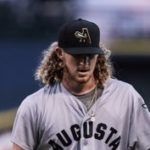 18. Joey Estes, RHP
18. Joey Estes, RHP
Age: 19
2.81 ERA | 3.29 FIP | 14 G, 14 GS | 67.1 IP | 2.41 BB/9 | 11.36 K/9 (A)
Acquired: Drafted, 16th Round – 2019
Prior Ranking: 40
Of the three prep pitchers taken on Day 3 of the 2021 draft, Estes has emerged as the most polished, experiencing good results at low-A. The California teenager has been one of the best starters in the Low-A East.
That said, Estes has plenty of development ahead of him. When he’s at his best, he is throwing his four-seam fastball in the mid-90s with arm-side action, backed with a hard-break slider that resembles the fastball out of the hand before darting away. He gets in trouble when the fastball slips into the low-90s without the action and sitting in the zone and the slider gets too much of the plate. Estes is a control-over-command pitcher at this point, but usually he has enough explosiveness to get swing-and-miss even if he misses his spots. His change-up is a work-in-progress, but has the potential for being a plus offering.
 19. Ambioris Tavarez, SS
19. Ambioris Tavarez, SS
Age: 17 | Bats: R
Acquired: International Amateur Free Agent – 2021
Prior Ranking: 11
It’s been over 4 years since Atlanta has been able to give an international amateur free agent a signing bonus of more than $300,000, and over 18 months since they’ve been able to give a bonus over $10,000. While still under sanctions during this signing period which cut the Braves available bonus pool in half, the team decided to give almost all of it to Dominican shortstop prospect Ambioris Tavarez.
Tavarez is already a big kid at 6′-2″ and 175 pounds as of last April, with room for more muscle. What stands out about Tavarez is his excellent bat speed which gives him strong raw power and hit tools. While it’s possible he’ll grow out of the position, he shows a strong arm from shortstop. While I am tentative to place untested young talent so high on this list (I learned a lesson when I put Kevin Maitan at #6 on my initial prospect list back in 2016), video that I am seeing and reports that I am reading are very exciting. Tavarez as of this writing hasn’t been assigned so he will likely make his pro debut in 2022.
 20. Trey Harris, OF
20. Trey Harris, OF
Age: 25 | Bats: R
.249/.326/.353 | 91 wRC+ | 6 HR | 3 SB | 7.2% BB | 16.8% K (AA)
Acquired: Drafted, 32nd Round – 2018
Prior Ranking: 18
So far, 2021 has been a bit of a disappointment for Harris, especially given the buzz coming off a spring training invitation. Harris’s bugaboo has been a general inability to generate loft; 52% of his contact in play has been on the ground, and that has eaten up his productivity. Harris is a high-contact hitter who rarely walks. Hitters have attacked him with breaking balls away, and he’s largely tapping them on the ground opposite field.
Harris works better when he can pull the ball with authority, but he currently seems to try to go inside-out on inside velocity, and he’s mostly grounding those pitches to the right side. Harris is a very aggressive hitter and will rarely strikeout or walk, but he will need to make an adjustment a advance.
 21. Indigo Diaz, RHP
21. Indigo Diaz, RHP
Age: 22
0.78 ERA | 0.96 FIP | 23 G, 0 GS | 34.2 IP | 2.86 BB/9 | 17.13 K/9 (AA/A+)
Acquired: Drafted, 27th Round — 2019
Prior Ranking: N/A
Diaz completely overwhelmed the High-A East with Rome as the most dominant reliever in that league before getting moved to AA where he’s essentially been just as dominant, so far not surrendering a run in 5 outings.
Diaz strikes an intimidating presence on the mound at 6′-5″, 250 pounds, and a defensive tackle’s build. Diaz throws a mid-90s fastball predominately; at its best it has rising action, but more often its straight and he sprays it in and around the zone. This is an effective wildness that makes hitters devolve into guessing. When it looks like a hitter may be timing up the fastball, he can unleash a sharp 12-6 slider to twist the hitter into knots.
 22. Darius Vines, RHP
22. Darius Vines, RHP
Age: 23
2.90 ERA | 3.66 FIP | 15 G, 15 GS | 71.1 IP | 2.65 BB/9 | 11.23 K/9 (A+/A)
Acquired: Drafted, 7th Round — 2019
Pre-Season Ranking: N/A
Vines started the season at Augusta where he posted a 2.25 ERA in 8 starts, confounding the typically younger opposition he was facing. He was promoted to Rome in late June and has looked comfortable, culminating in a Saturday start where he pitched 7 no-hit innings.
Vines has a relatively sophisticated four-pitch mix, with the curve a true plus pitch that has strong late downward break. He has de-emphasized this pitch however to work on his other offerings, especially his low-90s fastball. At its best it has some rising action with arm-side run and he can knock bats out of hands, though he can sometimes lose feel for the pitch and it becomes straight and hittable. He does a nice job tunneling with his developing slider, which has solid 9-1 break. His change-up has shown strong improvement as the year has progressed as well. All-in-all, Vines has put himself on the map as a possible middle relief possibility, with continued progression possible making him a big league starter.
 23. Justin Dean, OF
23. Justin Dean, OF
Age: 24 | Bats: R
.240/.360/.368 | 109 wRC+ | 5 HR | 22 SB | 10.8% BB | 34.0% K (AA)
Acquired: Drafted, 17th Round – 2018
Prior Year Ranking: 32
As was expected after the shutdown season and a major league spring training invite, Dean was challenged with a promotion to AA. He has held his own, using his ability to get on base to regularly terrorize opposing pitchers with his speed; he currently leads the Double-A South in stolen bases and is second in all of AA ball.
Dean is maintaining a good OBP out of the lead-off spot despite a high strikeout rate. This was more pronounced earlier in the season, and over the last month he has a more reasonable 26.4% K-rate. Dean has the bat speed to turn on velocity, and if he could get even a little more loft on the ball to stay away from groundouts, he should maintain solid batting averages on balls in play. Sometimes he has the bat speed to run into a home run, but that’s not his game.
His speed is an asset in the outfield, and he’s improved his routes since 2019. He does break the wrong way more often than sometimes is comfortable, but he has the speed to typically make up for this.
 24. Brooks Wilson, RHP
24. Brooks Wilson, RHP
Age: 25
1.99 ERA | 2.46 FIP | 21 G, 0 GS | 31.2 IP | 4.83 BB/9 | 13.93 K/9 (AA)
Acquired: Drafted, 7th Round – 2018
Prior Ranking: 42
Largely ignored by most evaluators as a senior sign out of Stetson in 2018, Wilson has done nothing but perform at every level since coming into pro ball. Challenged with a starting rotation assignment in high-A in 2019, Wilson turned in a 2.69 ERA in 63.2 innings. After the shutdown, Wilson was advanced to AA where he has pitched exclusively out of the bullpen, and where he as been one of the more dominant relievers at the level.
As a starter, Wilson used a split-finger fastball and a strong curveball to to induce groundballs. As a reliever he still has that mix, but he has apparently used the time during shutdown to develop a more traditional 4-seam fastball that sits 93-95 to give hitters a reason to change eye level. This has caused his strikeout rate to blow up as he’ll use the 4-seamer to set up the split for swing-and-miss. Wilson rarely gives in to the hitter, and if they are able to lay off the splitter, Wilson would rather walk the batter than lay in a fastball.
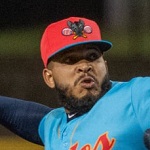 25. Daysbel Hernandez, RHP
25. Daysbel Hernandez, RHP
Age: 24
4.50 ERA | 3.57 FIP | 22 G, 0 GS | 28.0 IP | 4.18 BB/9 | 12.86 K/9 (AAA/AA)
Acquired: International Free Agent – 2017
Prior Ranking: 27
Coming off a strong Mexican Winter League campaign and a major league spring training invite, Hernandez was challenged with a AAA assignment, skipping AA. He wasn’t ready as his control deserted him and he was dropped to AA after five outings. Control has continued to be an issue with Hernandez, and the zip on the fastball that he showed with high-A Florida seems to have backed up slightly.
Hernandez has rallied in his more recent outings however, striking out 20 in his last 13 innings. Hernandez is a two-pitch reliever, using his mid-90s fastball to set up a sharp slider for swing-and-miss. Hitters this year have done a better job of staying off the slider, which generally is a ball.
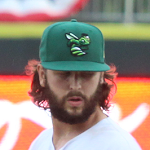 26. Jared Johnson, RHP
26. Jared Johnson, RHP
Age: 20
7.27 ERA | 7.22 FIP | 9 G, 9 GS | 26.0 IP | 6.23 BB/9 | 12.46 K/9 (A)
Acquired: Drafted, 14th Round – 2019
Prior Ranking: 34
After a delayed start to his full-season debut, Johnson joined the GreenJackets in mid-June. He has shown the promise that made him an overslot signing in 2019, but also has shown that he still has quite a bit of development ahead of him.
Johnson works a three-pitch mix of mid-90s fastball, low-90s sinker, and a mid-80s breaking ball. All three pitches flash as plus offerings, but Johnson doesn’t repeat well enough mechanically to be consistent with them. Because he still keeps the ball around the plate, that can result in loud contact.
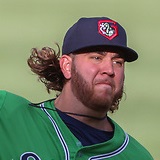 27. Nolan Kingham, RHP
27. Nolan Kingham, RHP
Age: 24
4.01 ERA | 4.54 FIP | 14 G, 14 GS | 76.1 IP | 2.48 BB/9 | 5.90 K/9 (AAA/AA)
Acquired: Drafted, 12th Round – 2018
Prior Year Ranking: 22
Kingham was riding the momentum of a quick rise through the minors in 2019 and a major league spring training invite. A spring injury limited his looks however, but he started out as the de facto ace of the Mississippi rotation. After getting good results with the M-Braves (55 IP, 2.29 ERA), Kingham was promoted to AAA Gwinnett in late June, where he has been knocked around quite a bit in his first exposure to the level
A rare command-over-stuff pitcher in this organization, Kingham relies on changing speeds and hitting spots to generate soft contact. It probably isn’t a surprise that the more-disciplined hitters at AAA give him trouble given his lack of a true strikeout pitch. It’s still possible he could refine one of his offspeed pitches more to give him that pitch, but results may be ugly for awhile.
 28. Cal Conley, SS
28. Cal Conley, SS
Age: 22
.329/.393/.587 | 15 HR | 7 SB | 8.3% BB | 14.9% K (NCAA – Big 12)
Acquired: Drafted, 4th Round – 2021
Prior Ranking: N/A
Conley’s scouting report coming out of the draft sounds a lot like the reports on Braden Shewmake in 2019 — a switch-hitter with good feel to hit from both sides, some raw power but not likely a major tool as he switches to wood bats, good hands at shortstop but not enough range or arm to stick there and likely a utility player in the long-term.
Shewmake turned out to me a much better defender than advertised, and he’s now starting to tap more into that raw power. Time will tell if Conley follows a similar path, but my video reviews show a player who can turn on velocity and with some small adjustments could be a source of average power.
 29. Adam Shoemaker, LHP
29. Adam Shoemaker, LHP
Age: 18
Acquired: Drafted, 11th Round – 2021
Prior Ranking: N/A
Due to the rules of the draft, 11th-round picks are always worth watching. They are almost always players that are highly sought by the drafting team and are guided to Day 3 where each pick has an automatic $125,000 signing bonus allowance that is not part of the overall bonus pool for the team. In 2020, the Braves took Shoemaker with that 11th pick.
Shoemaker is a project for Braves development. At 6′-6″ but only 185 pounds, he likely still has a lot of filling out to do, which is exciting because his fastball has already been clocked at 95 mph. Shoemaker is a low-mileage arm, having only started pitching his sophomore season of high school, but already has the aforementioned fastball and a heavy sinker. The Braves have had some success with raw prep pitchers in recent years, including Touki Toussaint and Freddy Tarnok.
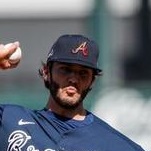 30. William Woods, RHP
30. William Woods, RHP
Age: 22
2019: 3.35 ERA | 4.16 FIP | 20 G, 7 GS | 51.0 IP | 5.12 BB/9 | 10.24 K/9 (A)
Acquired: Drafted, 23rd Round – 2018
Prior Year Ranking: 30
Woods was a spring training invite who impressed with a fastball that hit 99 in short stints late in games. Woods prefers to start however, so he was getting stretched out in minor league spring training when he suffered an injury late in camp. He has not made his 2021 debut.
When healthy, Woods features a high-90s four-seamer, a hard-break slider, and a fading change-up. In 2019 and in spring training command of all three pitches could come and go, and he tends to miss to the heart of the plate too much when he gets behind — when he can control it. This was set up to be a pivotal season for Woods to determine his future role; if he does make it back this season it seems likely that he will pitch out of the bullpen rather than try to get stretched out again.
The Next Ten
- Trey Riley, RHP
- Roddery Munoz, RHP
- Mahki Backstrom, 1B
- Tyler Owens, RHP
- Greyson Jenista, 1B/OF
- Brandol Mezquita, OF
- Kadon Morton, OF
- A.J. Smith-Shawver, RHP
- Willie Carter, OF
- Hayden Deal, LHP
